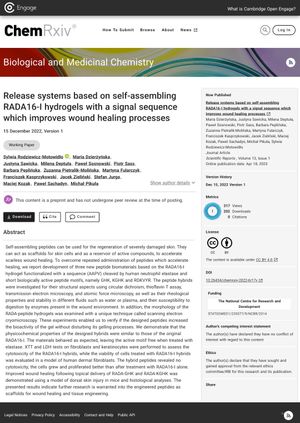Release Systems Based on Self-Assembling RADA16-I Hydrogels With a Signal Sequence Which Improves Wound Healing Processes
December 2022

TLDR New peptide biomaterials based on RADA16-I hydrogel can improve wound healing and could be used for tissue engineering.
The document discusses the development of three new peptide biomaterials based on the RADA16-I hydrogel, which is functionalized with a sequence cleaved by human neutrophil elastase and short biologically active peptide motifs. These peptides were tested for their structural aspects, rheological properties, stability in different fluids, and susceptibility to digestion by enzymes present in the wound environment. The designed peptides were found to have similar physicochemical properties to the original RADA16-I and behaved as expected. Cytotoxicity tests on fibroblasts and keratinocytes showed no cytotoxicity; cells grew and proliferated better than after treatment with RADA16-I alone. Improved wound healing was demonstrated using a model of dorsal skin injury in mice after topical delivery of two of the hybrid peptides. The results suggest that these engineered peptides could be used as scaffolds for wound healing and tissue engineering.
View this study on chemrxiv.org →
Related

research Release Systems Based on Self-Assembling RADA16-I Hydrogels With a Signal Sequence Which Improves Wound Healing Processes
New peptide biomaterials based on RADA16-I hydrogel can improve wound healing and could be used for tissue engineering.